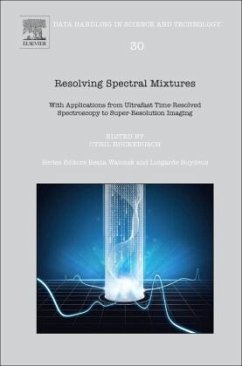Resolving Spectral Mixtures: With Applications from Ultrafast Time-Resolved Spectroscopy to Superresolution Imaging offers a comprehensive look into the most important models and frameworks essential to resolving the spectral unmixing problem-from multivariate curve resolution and multi-way analysis to Bayesian positive source separation and nonlinear unmixing. Unravelling total spectral data into the contributions from individual unknown components with limited prior information is a complex problem that has attracted continuous interest for almost four decades.
Spectral unmixing is a topic of interest in statistics, chemometrics, signal processing, and image analysis. For decades, researchers from these fields were often unaware of the work in other disciplines due to their different scientific and technical backgrounds and interest in different objects or samples. This led to the development of quite different approaches to solving the same problem. This multi-authored book will bridge the gap between disciplines with contributions from a number of well-known and strongly active chemometric and signal processing research groups.
Among chemists, multivariate curve resolution methods are preferred to extract information about the nature, amount, and location in time (process) and space (imaging and microscopy) of chemical constituents in complex samples. In signal processing, assumptions are usually around statistical independence of the extracted components. However, the chapters include the complexity of the spectral data to be unmixed as well as dimensionality and size of the data sets. Advanced spectroscopy is the key thread linking the different chapters. Applications cover a large part of the electromagnetic spectrum. Time-resolution ranges from femtosecond to second in process spectroscopy and spatial resolution covers the submicronic to macroscopic scale in hyperspectral imaging.
Spectral unmixing is a topic of interest in statistics, chemometrics, signal processing, and image analysis. For decades, researchers from these fields were often unaware of the work in other disciplines due to their different scientific and technical backgrounds and interest in different objects or samples. This led to the development of quite different approaches to solving the same problem. This multi-authored book will bridge the gap between disciplines with contributions from a number of well-known and strongly active chemometric and signal processing research groups.
Among chemists, multivariate curve resolution methods are preferred to extract information about the nature, amount, and location in time (process) and space (imaging and microscopy) of chemical constituents in complex samples. In signal processing, assumptions are usually around statistical independence of the extracted components. However, the chapters include the complexity of the spectral data to be unmixed as well as dimensionality and size of the data sets. Advanced spectroscopy is the key thread linking the different chapters. Applications cover a large part of the electromagnetic spectrum. Time-resolution ranges from femtosecond to second in process spectroscopy and spatial resolution covers the submicronic to macroscopic scale in hyperspectral imaging.



